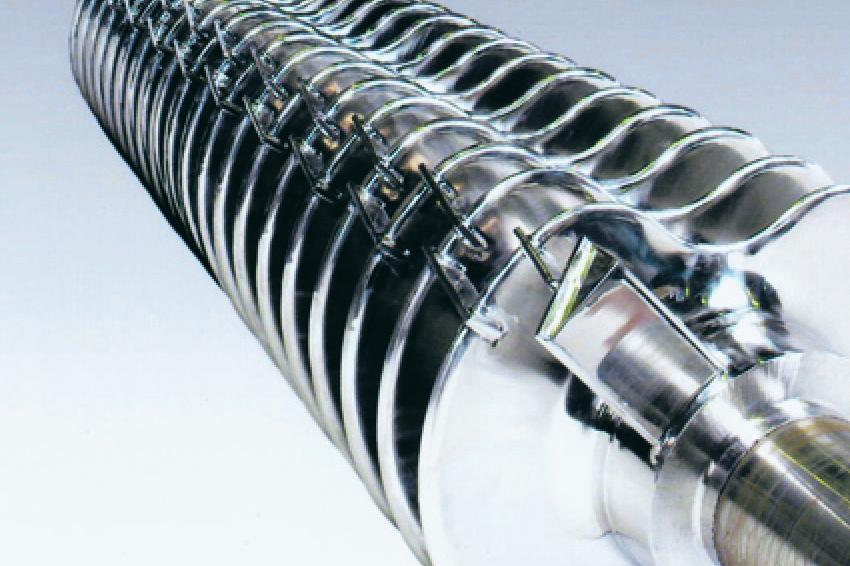Versatile drying units can do it all – and even more
11.04.2013 -
An All Rounder - Sometimes, what it takes to get the job done is highly specialized equipment. Nevertheless, quite often universal all-rounder units with their high flexibility have a lead : By combining process steps like sterilizing, crystallizing, calcining, coating or reacting substances, modern Boono dryers/coolers can be used in a variety of applications.
Pellets, pastes and wet powders - Boono dryers/coolers are versatile devices. They can be used to dry, heat up or cool down with any heat medium, from animal feed to plastics and polymers providing a thorough mixing and gentle heat transfer. Nara has developed a Boono dryer/cooler that provides an indirect heat transfer, so that the product has no direct contact with the transfer heat medium. The hollow shaft, Boono wings, and the double-walled trough are heated or cooled with water, steam or oil, providing a large contact surface with the product. The gas flow through the product during drying removes vapours and prevents condensation. This minimizes the emission of gas and the minimization of loss of heat.
From a commercial point of view, there are several advantages : Pneumatic conveyer type dryers can only be used for short-time drying processes, since they do not allow the configuration of a residence time. Fluid bed dryers have greater air and gas consumption and require larger-sized components such as fans and air vents. Further, more hot gas is released to the environment. Thus, the energy loss of fluid bed units is significantly higher.
Boono Dryers/Coolers have multiple applications - these include drying materials or substances from more than 50% moisture to ppm values, improving a substance's morphology, or reducing amounts of waste.
Drying
Nara paddle type dryers/coolers can be used for a variety of applications - one is drying modified starch. In contrast to native starch, modified starch must be kept at a certain temperature during drying to obtain the desired characteristics. An application for wheat is similar to this procedure. In this case, the machine was also used as a reactor in order to weaken the wheat's gas holding capacity. In a second process which is also reactive, wheat powder was roasted, enabling it to then be used as a component in curry powder.
Sterilizing
Another challenge is the partial sterilization of animal feed, or additives for forage. When animal feed is being processed, the target is to reduce the amount of microorganisms below a critical limit. This is achieved by raising the product's temperature from room temperature to 75-80℃ by heating. Steam is also fed into the process in order to accelerate the desired reduction in bacteria. The Boono wing geometry is adjusted accordingly to ensure optimal residence time and particularly even transport of the product through the machine. Good results have already been achieved when sterilizing fishmeal and wheat starch.
Processing
A frequent application is drying and cooling of amino acids or proteins. Protein processing is used in the food sector for confectionery, seasoning or health drinks. The number of applications requires high flexibility in terms of process layout. It can be generally said that not only cooling, drying and heating are important process steps, but also the product changes taking place simultaneously. As a result, the amino acids are chemically changed or modified in the machine, creating new desired characteristics.
Crystallizing
A further application is to heat material that is then kept at a constant temperature for a certain period of time. The plastics industry uses this process to allow polymers to crystallize further, for example. At an advanced stage of crystallization, the characteristics of the monopolymer, copolymer or terpolymer change, enable new, improved products to be manufactured with these modified substances.
Keeping the Temperature
In addition to drying, the heat transfer area can also be used for other temperature dependent procedures. For example, materials can be reacted in the dryer or modified in terms of their chemical structure. The latter can be a crystallization process, but also a destructive process. The powder's initial structure is destroyed - a substance that irritates the skin is treated in such a way that irritant effect is reduced or allayed while retaining its effectiveness.
Since the main part of the dryer's heat transfer zone consists of an arrangement of v-shaped Boono wings, there is a large and effective heat transfer area. The result is a compact, requiring little space for set up.
Characteristics and Benefits
With the Boono wings(Nara paddle type wings) moving with a rotation frequency of only 10 to 40 revolutions per minute, abrasion and material wear are reduced to a minimum. This also reduces the risk of material breakage. A homogeneous heat transfer is guaranteed due to the continuous and thorough mixing by the Boono wings‘opposite rotation and their v-shaped, sloping surfaces. The Boono wing's alternating interlocking movements and their proximity to the container's inner surface provide a continuous self-cleaning of the device.
The drying sequence and residence time can be controlled and set easily thus allowing for customizing to the physical characteristics of the material. It is possible to adjust the number of shafts or wings, the number of revolutions, the temperature and the processing time.
Thanks to the continuous thorough mixing of the material by the alternating interlocking Boono wings, viscous materials with a very high moisture content can be processed. The dryers design prevents the settling of product deposits by eliminating dead spots.
Contact
NARA Machinery Europe Co. Ltd.
Europaallee 46
50226 Frechen
Germany
+49 2234 2776 0
+49 2234 23067





